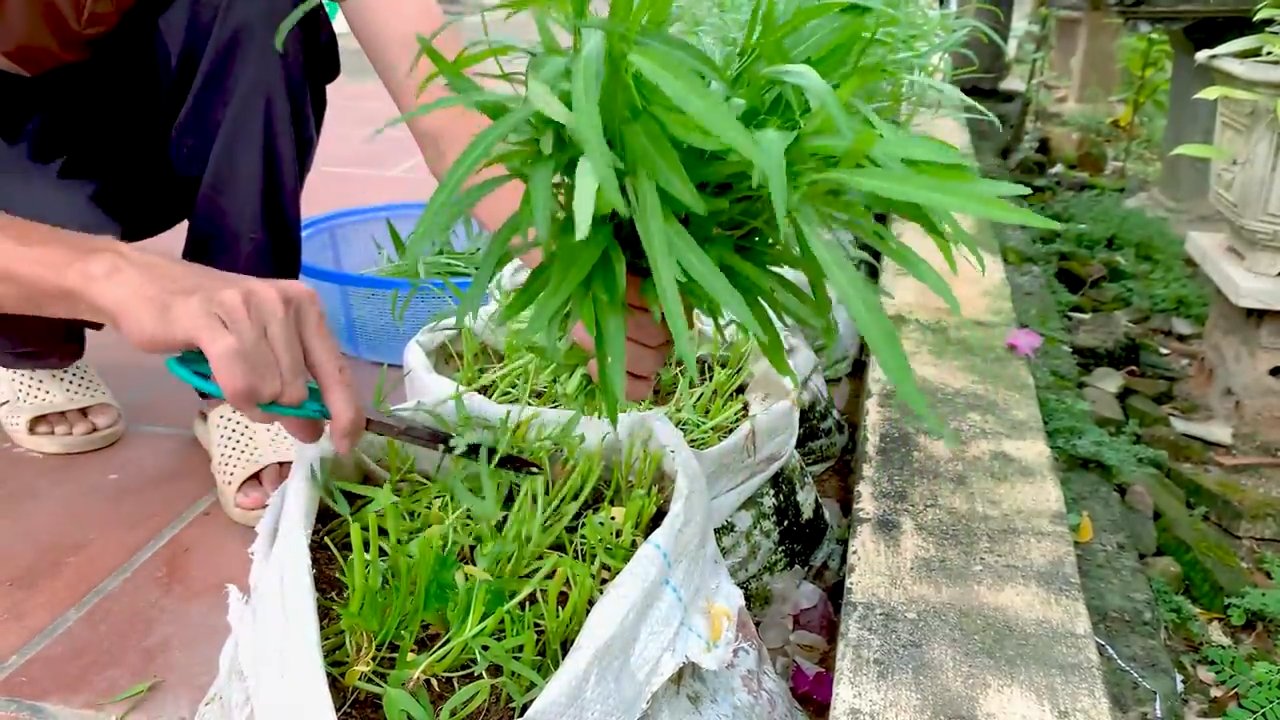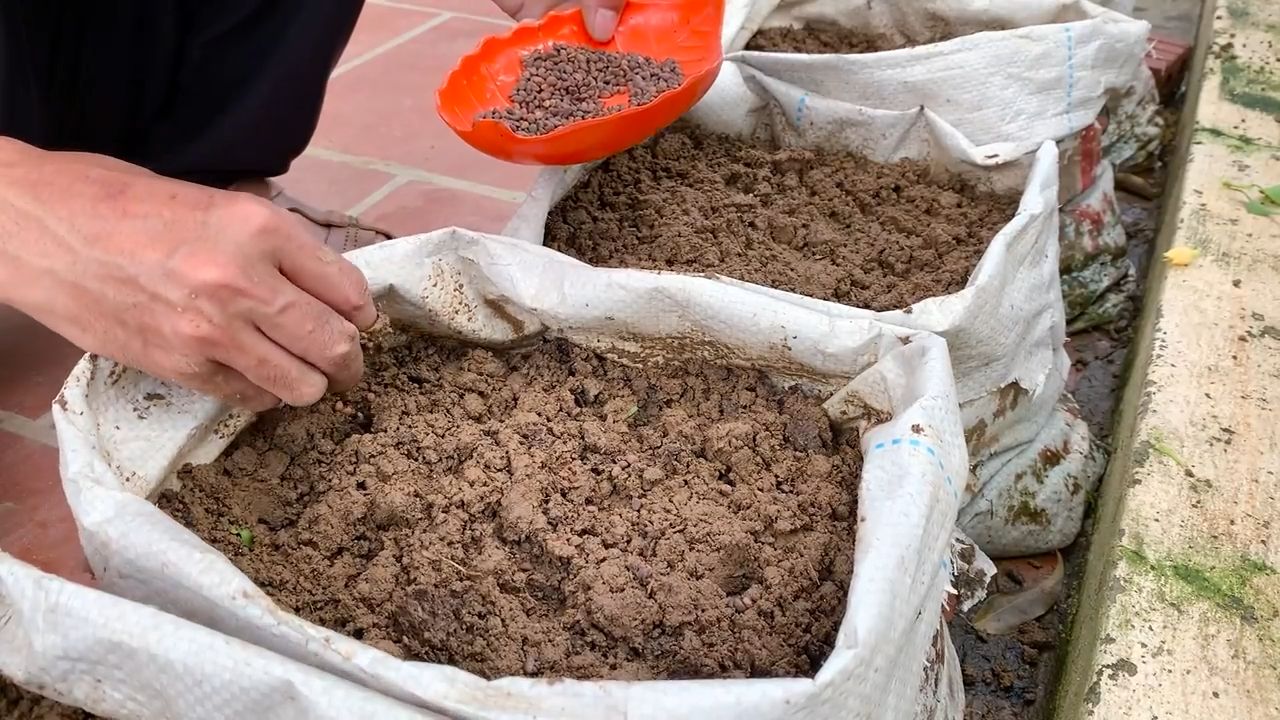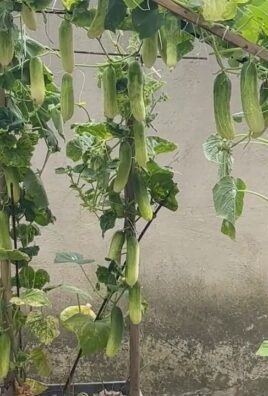Grow Summer Water Spinach, also known as Ong Choy or Kang Kong, right in your backyard! Imagine stepping outside and harvesting fresh, crisp, and delicious greens for your stir-fries, salads, or soups. Forget those wilted, overpriced bunches at the grocery store – with a few simple tricks, you can cultivate your own thriving patch of this nutritious and versatile vegetable.
Water spinach has a rich history, deeply rooted in Southeast Asian cuisine. For centuries, it has been a staple in dishes across the region, prized for its mild flavor and impressive nutritional benefits. It’s packed with vitamins, minerals, and antioxidants, making it a healthy and delicious addition to any meal. I’ve always been fascinated by how different cultures have embraced this amazing plant.
But why should *you* learn to grow summer water spinach? Well, beyond the health benefits and culinary versatility, it’s incredibly rewarding! Plus, in today’s world, knowing how to grow your own food is becoming increasingly important. It’s a fantastic way to reduce your carbon footprint, save money, and connect with nature. This DIY guide will provide you with easy-to-follow instructions and clever hacks to ensure a bountiful harvest, even if you’re a complete beginner. Let’s get our hands dirty and start growing!

Growing Summer Water Spinach (Ong Choy) in Your Backyard: A DIY Guide
Hey there, fellow gardening enthusiasts! I’m so excited to share my experience growing water spinach, also known as Ong Choy, right in my backyard. This leafy green is a staple in Asian cuisine, and it’s surprisingly easy to cultivate at home, especially during the summer months. Get ready to have a constant supply of fresh, delicious greens!
What You’ll Need
Before we dive in, let’s gather all the necessary materials. This will make the process smoother and more enjoyable.
* Water Spinach Seeds or Cuttings: You can find these at most Asian grocery stores or online seed suppliers. I personally prefer starting with seeds, but cuttings work just as well.
* A Large Container or a Dedicated Garden Bed: Water spinach thrives in waterlogged conditions, so choose a container without drainage holes or prepare a section in your garden that can be consistently flooded. A kiddie pool works great too!
* Potting Mix or Garden Soil: A rich, well-draining soil is essential for healthy growth. I like to use a mix of potting mix, compost, and a little bit of aged manure.
* Fertilizer: A balanced fertilizer, like a 10-10-10, will provide the necessary nutrients for vigorous growth. I also supplement with liquid seaweed extract.
* Water: Lots and lots of water! This is water spinach, after all.
* Sunlight: Water spinach needs at least 6 hours of direct sunlight per day.
* Optional: A small pump to circulate the water (especially if you’re using a large container).
Starting from Seeds: A Step-by-Step Guide
If you’re starting from seeds, here’s how to get them germinated and ready for planting.
1. Soaking the Seeds: To improve germination rates, soak the water spinach seeds in warm water for 24 hours. This helps soften the seed coat and encourages sprouting. I usually put them in a small bowl and cover them with water.
2. Preparing the Seed Starting Tray: Fill a seed starting tray with a good quality seed starting mix. Moisten the mix thoroughly.
3. Sowing the Seeds: Sow the seeds about 1/2 inch deep and 1 inch apart in the seed starting tray. Gently cover them with the seed starting mix.
4. Maintaining Moisture: Keep the seed starting mix consistently moist by misting it with water regularly. You can also cover the tray with a plastic dome or plastic wrap to create a humid environment.
5. Providing Warmth: Water spinach seeds germinate best in warm temperatures (around 70-80°F). Place the seed starting tray in a warm location, such as a sunny windowsill or under a grow light.
6. Germination: The seeds should germinate within 7-14 days. Once the seedlings emerge, remove the plastic dome or plastic wrap.
7. Transplanting: Once the seedlings have developed a few sets of true leaves (usually after 2-3 weeks), they’re ready to be transplanted into your container or garden bed.
Starting from Cuttings: An Alternative Method
If you have access to water spinach cuttings, this is an even faster way to get started.
1. Selecting Cuttings: Choose healthy, vigorous stems that are about 6-8 inches long. Remove the lower leaves from the cuttings, leaving only a few leaves at the top.
2. Rooting the Cuttings: Place the cuttings in a glass or jar filled with water. Make sure the water covers the nodes (the points where the leaves were removed).
3. Changing the Water: Change the water every 1-2 days to prevent bacterial growth.
4. Root Development: Within a week or two, the cuttings should develop roots. Once the roots are about 1-2 inches long, they’re ready to be planted.
Preparing Your Growing Area
Whether you’re using a container or a garden bed, proper preparation is key.
1. Choosing a Location: Select a location that receives at least 6 hours of direct sunlight per day. Water spinach loves the sun!
2. Container Preparation: If you’re using a container, make sure it’s large enough to accommodate the mature plants. A container that’s at least 12 inches deep and 18 inches wide is a good starting point. Ensure there are no drainage holes, or plug them securely.
3. Garden Bed Preparation: If you’re using a garden bed, amend the soil with compost and aged manure to improve its fertility and drainage. You’ll also need to create a shallow depression or basin that can be flooded with water. I like to build up the edges of the bed with soil to create a dam.
4. Filling with Soil: Fill the container or garden bed with a rich, well-draining soil mix. I use a combination of potting mix, compost, and aged manure.
Planting Your Water Spinach
Now comes the fun part – planting!
1. Transplanting Seedlings: Gently remove the seedlings from the seed starting tray and plant them about 6-8 inches apart in the prepared container or garden bed.
2. Planting Cuttings: Plant the rooted cuttings about 6-8 inches apart in the prepared container or garden bed.
3. Watering Thoroughly: After planting, water the seedlings or cuttings thoroughly.
4. Flooding the Area: Once the plants are established (after a few days), flood the container or garden bed with water. The water level should be about 2-3 inches above the soil surface.
Caring for Your Water Spinach
Consistent care is essential for a bountiful harvest.
1. Maintaining Water Levels: Keep the container or garden bed consistently flooded with water. Check the water level daily and add water as needed. Water spinach thrives in waterlogged conditions, so don’t be afraid to overwater.
2. Fertilizing Regularly: Fertilize the water spinach every 2-3 weeks with a balanced fertilizer. I like to use a 10-10-10 fertilizer, but you can also use a liquid seaweed extract.
3. Controlling Pests and Diseases: Water spinach is generally resistant to pests and diseases, but keep an eye out for aphids, spider mites, and fungal diseases. If you notice any problems, treat them promptly with an appropriate insecticide or fungicide. I prefer using organic solutions whenever possible.
4. Providing Support (Optional): As the water spinach grows, it may need some support. You can use stakes or trellises to keep the plants upright. However, I usually let mine sprawl along the ground.
Harvesting Your Water Spinach
The best part of growing your own water spinach is the delicious harvest!
1. When to Harvest: You can start harvesting water spinach about 4-6 weeks after planting. The leaves and stems should be about 6-8 inches long.
2. How to Harvest: Use a sharp knife or scissors to cut the stems about 2-3 inches above the water surface. This will encourage new growth.
3. Harvesting Regularly: Harvest the water spinach regularly to encourage continuous production. The more you harvest, the more it will grow!
4. Storing Your Harvest: Freshly harvested water spinach can be stored in the refrigerator for up to a week. Wrap it in a damp paper towel and place it in a plastic bag.
Tips for Success
Here are a few extra tips to help you grow the best water spinach possible:
* Choose the Right Variety: There are several varieties of water spinach available, so choose one that’s well-suited to your climate and growing conditions.
* Provide Adequate Sunlight: Water spinach needs at least 6 hours of direct sunlight per day. If you don’t have enough sunlight, you can supplement with grow lights.
* Maintain Warm Temperatures: Water spinach grows best in warm temperatures (around 70-80°F). If you live in a cooler climate, you may need to start your plants indoors or use a greenhouse.
* Control Algae Growth: Algae can sometimes grow in the water, especially in sunny locations. To control algae growth, you can add a small amount of hydrogen peroxide to the water or use an algae control product. A small pump to circulate the water can also help.
* Don’t Be Afraid to Experiment: Gardening is all about experimentation, so don’t be afraid to try new things and see what works best for you.
Enjoy Your Homegrown Water Spinach!
Growing water spinach at home is a rewarding experience. You’ll have a constant supply of fresh, delicious greens that you can use in a variety of dishes. From stir-fries to soups, water spinach adds a unique flavor and texture to any meal. So, get started today and enjoy the fruits (or rather, vegetables) of your labor

Conclusion
So, there you have it! Growing your own summer water spinach, also known as kangkong or ong choy, is not only achievable but incredibly rewarding. We’ve walked you through the simple steps, from sourcing your seeds or cuttings to nurturing your plants and harvesting your delicious, leafy greens. But why should you bother with this DIY project when you can potentially find it at the store? The answer lies in freshness, flavor, and control.
Imagine the vibrant, crisp texture of freshly harvested water spinach, bursting with a slightly sweet and nutty flavor that store-bought varieties often lack. Think about the satisfaction of knowing exactly where your food comes from and that it’s free from harmful pesticides or chemicals. That’s the power of growing your own.
Beyond the basic method we’ve outlined, there’s plenty of room for experimentation. Try different growing mediums, such as hydroponics, for a faster and potentially higher yield. Explore various kangkong varieties; some are more heat-tolerant than others, while some boast thicker stems or broader leaves. You can even experiment with different fertilizers to see which one promotes the most vigorous growth.
Consider companion planting to enhance your water spinach’s growth and deter pests naturally. Basil, mint, and marigolds are excellent choices. They not only add beauty to your garden but also offer beneficial properties that can protect your kangkong from common garden invaders.
Don’t be afraid to get your hands dirty and embrace the learning process. Gardening is a journey, and every success and setback offers valuable lessons. The key is to be patient, observant, and adaptable. Pay attention to your plants’ needs, adjust your watering and fertilizing schedule as necessary, and don’t hesitate to seek advice from fellow gardeners or online resources.
Growing summer water spinach is more than just a gardening project; it’s an investment in your health, your taste buds, and your connection to nature. It’s a chance to experience the joy of nurturing life from seed to table and to savor the unparalleled flavor of homegrown produce.
We wholeheartedly encourage you to give this DIY trick a try. Whether you have a sprawling backyard or a small balcony, there’s a way to incorporate water spinach into your growing space. Start small, learn as you go, and don’t be discouraged by initial challenges. The rewards are well worth the effort.
Once you’ve harvested your first batch of homegrown kangkong, we’d love to hear about your experience! Share your photos, tips, and recipes in the comments below. Let’s create a community of water spinach enthusiasts and inspire others to embark on this rewarding gardening adventure. Let us know what worked for you, what challenges you faced, and any unique variations you tried. Your insights could be invaluable to other aspiring gardeners.
So, grab your seeds or cuttings, prepare your growing medium, and get ready to experience the joy of growing your own summer water spinach. Happy gardening!
Frequently Asked Questions (FAQ)
What are the best conditions for growing summer water spinach?
Summer water spinach thrives in warm, humid environments with plenty of sunlight. Aim for at least 6 hours of direct sunlight per day. The ideal temperature range is between 75°F and 85°F (24°C and 29°C). Water spinach also prefers moist soil, so regular watering is essential, especially during hot and dry periods. Consider growing it near a water source or in a container that allows for easy watering.
How often should I water my water spinach plants?
Water spinach is a water-loving plant, so it needs consistent moisture. Water deeply whenever the top inch of soil feels dry to the touch. During hot weather, you may need to water daily or even twice a day. Ensure proper drainage to prevent waterlogging, which can lead to root rot. If you’re growing water spinach in containers, check the soil moisture more frequently, as containers tend to dry out faster than garden beds.
What kind of fertilizer should I use for water spinach?
Water spinach benefits from regular fertilization to promote vigorous growth. A balanced fertilizer with equal parts nitrogen, phosphorus, and potassium (e.g., 10-10-10) is a good starting point. You can also use organic fertilizers such as compost tea, fish emulsion, or seaweed extract. Apply fertilizer every 2-3 weeks, following the instructions on the product label. Avoid over-fertilizing, as this can lead to excessive foliage growth at the expense of flavor.
How long does it take for water spinach to grow?
Water spinach is a fast-growing plant. You can typically start harvesting leaves within 4-6 weeks of planting. The exact time will depend on the growing conditions, such as temperature, sunlight, and soil fertility. Regular harvesting encourages further growth, so don’t be afraid to start picking leaves as soon as they reach a usable size.
What are some common pests and diseases that affect water spinach?
Water spinach is generally resistant to pests and diseases, but it can be susceptible to aphids, spider mites, and fungal diseases like leaf spot. Inspect your plants regularly for signs of infestation or disease. If you notice any problems, take action promptly. For aphids and spider mites, you can try spraying the plants with a strong stream of water or using insecticidal soap. For fungal diseases, ensure good air circulation and avoid overhead watering. You can also use a fungicide if necessary.
Can I grow water spinach in a container?
Yes, water spinach grows well in containers. Choose a container that is at least 12 inches deep and wide to provide enough space for the roots to grow. Use a well-draining potting mix and ensure that the container has drainage holes. Place the container in a sunny location and water regularly. Container-grown water spinach may require more frequent watering and fertilization than plants grown in the ground.
How do I harvest water spinach?
Harvest water spinach by cutting the stems about 6 inches from the base of the plant. This will encourage new growth from the cut stems. You can harvest leaves and stems as needed. Regular harvesting will keep the plants productive and prevent them from becoming too leggy.
Can I grow water spinach indoors?
While water spinach prefers outdoor conditions, it can be grown indoors with sufficient light and humidity. Place the plants near a sunny window or use grow lights to provide adequate illumination. Maintain a warm and humid environment by misting the plants regularly or using a humidifier. Indoor-grown water spinach may not grow as quickly or produce as much foliage as outdoor plants, but it can still be a rewarding experience.
Is water spinach safe to eat?
Yes, water spinach is generally safe to eat when grown in clean water and soil. However, it’s important to wash the leaves thoroughly before consumption to remove any dirt or debris. Avoid growing water spinach in contaminated water or soil, as it can absorb pollutants. If you’re unsure about the water quality, it’s best to boil the water spinach before eating it.
What are some ways to cook with water spinach?
Water spinach is a versatile vegetable that can be used in a variety of dishes. It can be stir-fried, steamed, boiled, or added to soups and stews. It pairs well with garlic, ginger, chili peppers, and soy sauce. Some popular water spinach recipes include stir-fried water spinach with garlic, water spinach salad with peanut sauce, and water spinach soup with tofu. Experiment with different flavors and cooking methods to find your favorite way to enjoy this delicious and nutritious vegetable.




Leave a Comment